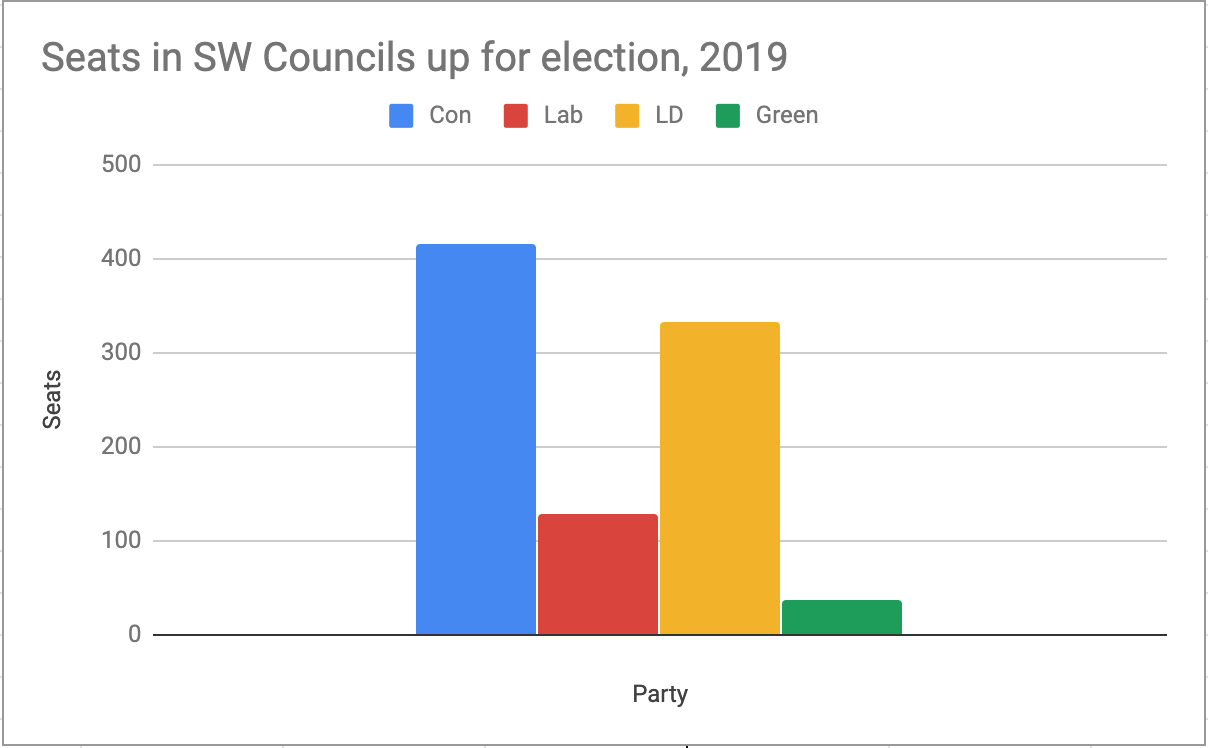Modelling the European elections
Plenty of people have been trying to model the European elections in an attempt to get a better handle on how to game the d’Hondt voting system. Several Remainers are part of tactical voting groups, where recommendations are put out, often hijacked by partisans of all sides. But unfortunately none of the approaches seem to be particularly statistically thorough.
I’ve created a model which is based off past election results and opinion polls, compared to how well the parties actually did in each region of England in those elections. More specifically, it works out how much each party underperformed or overperformed by in each region, compared to the national results, and also the opinion polls. It then takes an average of these under/overperformance quotients, weighted in different ways (eg the 2014 European u/o quotient is weighted more heavily than the 2016 local elections u/o quotient because they are the same type of election, while the 2019 local elections u/o quotient is weighted more heavily than the 2015 local elections u/o quotient because they were more recent).
The result of this is that I have a regional swing model which takes past evidence of how close opinion polls and actual results were in each region to calculate how each party will do in each region based off national opinion polls now (the only ones with proper weighting). This is not an exact science at all. It is based off a lot of educated guesswork and assumptions as to how opinion is changing over time. But it is based on real life results that have happened over the past few years.
As such, it enables me to see how close each party is to winning a seat, and thus make tactical recommendations, if I plug in a recent European election poll. I’m doing this based on the latest YouGov poll (they most accurately predicted the 2014 election, and the 2017 general election). I’ll briefly give some analysis of each region and the tactical recommendations below.
As a warning, you will notice that in a lot of places, the Lib Dems are the tactical recommendation. I know some groups on Facebook have been suspicious of this, but this is just what my model is telling me, based on compiling a lot of statistics and a lot of evidence. Unfortunately for the Green Party (who, as can be seen from previous posts on this page, I have a lot of time and respect for), it is just indisputable fact that opinion polls are quite consistently showing the Lib Dems very far ahead now nationally, and so this is reflected in the regional totals. There are, however, a couple of places where the Lib Dems (often on their third or fourth round) and Greens are so close that making a tactical recommendation would be misleading. In those, I lay out the numbers, and the decision is left up to the reader.
And finally, in these recommendations, I prioritise the number of Remain MEPs *overall*. For full disclosure, I am a Lib Dem member, but these recommendations seek to maximise the number of Remain MEPs to try to get the stop Brexit message out there. In some places, this means defending a final Remain seat where the Brexit Party is close to taking it. In others where Remain seats aren’t under threat, it means going on the offensive and recommending shifts in votes to win an additional Remain MEP. Currently, my model projects pro-EU parties winning 16 MEPs. If my advice is followed, we could increase that to 22 MEPs, almost double the number of Labour and the Tories combined.
Anyway, onto the recommendations and projections. (Numbers may not add up to 100% due to rounding, weighting, and minor parties)
East Midlands
Projections – BXP 42.3 // Lab 15.2 // LD 12.6 // Con 10.0 // Grn 7.6 // CUK 3.9
Predicted order of election: 1. BXP – 2. BXP – 3. Lab – 4. BXP – 5. Lib Dem
Analysis: The final seat here goes to the Lib Dems, where their undivided total of 12.6% beats out the Brexit Party who on their fourth round have 10.6%. This means that the Lib Dems beat the Brexit Party to the final seat. This also means that the Lib Dems are just 2% away from losing that seat to the Brexit Party, while the Greens are a larger 3.1% away from winning a seat. With that in mind, Remainers should vote Lib Dem.
East of England
Projections – BXP 40.3 // LD 16.6 // Con 11.0 // Lab 10.6 // Grn 10.6 // CUK 5.2
Predicted order of election: 1. BXP – 2. BXP – 3. Lib Dem – 4. BXP – 5. Con – 6. Grn – 7. Lab
Analysis: The final seat here goes to Labour, a pro-Brexit party. The nearest Remain party to their 10.6% share is the Lib Dems, who in the second round have a share of 8.3%. Meanwhile, Change UK have a share of 5.2% which will be entirely wasted based on these statistics. A movement of 4% to the Lib Dems would give the Remain parties an additional seat. Meanwhile, the Greens would require an extra 10% in the first round to gain a second seat. With that in mind, Remainers should vote Lib Dem.
London
Projections – Lab 22.1 // BXP 21.7 // LD 16.0 // Grn 12.6 // Con 8.5 // CUK 5.0
Predicted order of election: 1. Lab – 2. BXP – 3. LD – 4. Grn – 5. Lab – 6. BXP – 7. Con – 8. LD
Analysis: The final seat here goes to the Lib Dems, who pick it up on their second round with 8%. The closest competitor here is the pro-Brexit Labour Party, who on round three get 7.4%. It looks like London might just edge three Remain seats, and the priority should be in protecting that final one. The way to do so is to prevent Labour winning it, and so Remainers should vote Lib Dem.
North East
Projections – BXP 39.2 // Lab 22.4 // LD 13.9 // Grn 7.0 // Con 6.6 // CUK 4.3
Predicted order of election: 1. BXP – 2. Lab – 3. BXP
Analysis: The North East is horribly disproportionate due to only having three seats. The Brexit Party wins the final seat on its second round with 19.6%, with the Lib Dems being the closest competitors by a long way on 13.9%. Because there is only really one opportunity for a Remain MEP here, the focus should be on combining behind one Remain party because of how disproportionate the constituency is. As a result, my strong recommendation is that all Remainers vote Lib Dem to push them over that threshold.
North West
Projections – BXP 35.6 // Lab 20.9 // LD 15.2 // Grn 8.8 // Con 7.6 // CUK 4.4
Predicted order of election: 1. BXP – 2. Lab – 3. BXP – 4. Lib Dem – 5. BXP – 6. Lab – 7. BXP – 8. Grn
Analysis: The Greens win the final seat here, but are not massively at risk – their closest competitor is the Lib Dems in their second round on 7.6%. Additional votes for the Greens could push them above the Brexit Party, while additional votes for the Lib Dems could just eke them over the threshold to gain a second seat, taking the total Remain tally up to 3 MEPs. Tactical recommendations here are tough here as a result.
South East
Projections – BXP 37.9 // LD 20.1 // Con 11.8 // Grn 11.5 // Lab 8.9 // CUK 6.0
Predicted order of election: 1. BXP – 2. Lib Dem – 3. BXP – 4. BXP – 5. Con – 6. Grn – 7. Lib Dem – 8. BXP – 9. Lab – 10. BXP
Analysis: The final seat here is won by the Brexit Party in their fifth round, on 7.58%. The Lib Dems are the closest competitors on 6.69% in their third round. In terms of raw votes, this means the Lib Dems only require an extra 2.7% to beat the Brexit Party and win a third seat in the South East. Unfortunately, the Greens would need an extra 3.6%, which is more than the Lib Dems. The difference in percentages may be small, but in raw votes in this huge region, that could be quite a few. As such, the tactical recommendation is to vote Liberal Democrat to ensure a fourth Remain MEP (3 Lib Dem, 1 Grn).
South West
Projections – BXP 40.3 // LD 26.8 // Grn 15.6 // Con 11.0 // Lab 8.4 // CUK 2.0
Predicted order of election: 1. BXP – 2. Lib Dem – 3. BXP – 4. Green – 5. BXP – 6. Lib Dem
Analysis: The final seat here is won by the Lib Dems, who are at 13.41% in their second round. The closest competitor is the Conservative Party, who lag behind on 11% in their first round. There doesn’t appear to be a realistic prospect of gaining an additional Remain MEP here (three seems to be the practical limit based on current polling), so the only tactical thing to do would be to defend the final Lib Dem seat by voting Lib Dem. Like the North West, however, tactical decisions are difficult here.
Yorkshire and the Humber
Projections – BXP 40.6 // Lab 18.1 // LD 16.5 // Grn 7.2 // Con 6.6 // CUK 4.6
Predicted order of election: 1. BXP – 2. BXP – 3. Lab – 4. Lib Dem – 5. BXP – 6. BXP
Analysis: The final seat here is won by the Brexit Party, who are on 10.15% in their final round. Their closest pro-Remain competitor is the Lib Dems on 8.27%. Green and Change UK votes are currently wasted, meanwhile a small increase of the raw Lib Dem share by just 4% – around a third of the Green/CUK share at present – would secure the Lib Dems a second seat, and a second Remain voice in the region. The tactical advice therefore has to be to vote Lib Dem.
West Midlands
Projections – BXP 40.8 // LD 16.4 // Lab 16.2 // Con 9.4 // Grn 6.7 // CUK 4.0
Predicted order of election: 1. BXP – 2. BXP – 3. Lib Dem – 4. Lab – 5. BXP – 6. BXP – 7. Con
Analysis: The final seat here is won by the Conservative Party on 9.4%. Their closest competitor is the Lib Dems on 8.2%. The Lib Dems in raw votes would require an extra 2.54% to win the seat, while the Greens would need an extra 2.89%. It is exceptionally close here. Tentatively, the tactical advice is to vote Lib Dem in an effort to deprive the Tories of the final seat, but that isn’t for certain, and polling may change this in future.

